Genre: Platformer Developer: Sims Co. Publisher: Sega Ent. Players: 1 Released: 1994
Disney’s Aladdin, the tie-in game to its 1993 movie, is widely considered to be one of the best platformers of the Sega Genesis, if not of its era. The game developed by a pre-Shiny Entertainment Dave Perry and supplied with hand-drawn animations by real Disney animators was a very smooth “jump & run” with great graphics and tight gameplay that to this day holds many fans. The SNES, meanwhile, received an entirely different version of Aladdin that was created by Capcom. That rendition was also held in high regard by critics. Although it has no similarities with the Genesis version whatsoever, aside from the license, it is also considered quite a good game it its own right.
Strangely enough though, the Mega Drive version of Aladdin was also ported to the Nintendo Gameboy and the NES – but not to Sega’s own 8-bit-consoles. Rather than a watered down port, the Sega Master System received a version of Aladdin that was not only created by a different development team but that is also an entirely new platformer altogether. People tend to overlook the game, probably expecting an inferior version of its critically acclaimed namesake. Which is a shame, because it actually is a pretty good game in its own right.
What’s also funny is that out of the three different versions created, it’s Sega’s 8-Bit-incarnation of Aladdin that follows the movie the closest. The SNES version took quite a few liberties, even creating a couple of levels centered around locations and events that weren’t in the movie. The Genesis recreation was more faithful, but still played quite loosely when it came to enemy or level design – or the fact that Aladdin is fighting back with a sword the whole time. The Master System version, however, sticks quite close to the movie – all the way down to even recreating some sequences of the film in small animated cut scenes that take their lines directly from the script. Familiar tunes are realized recognizably quite well with the help of the PCM chip (no FM support though), and the graphics are full of little details, ranging from a (for 8-bit-systems) respectable number of animation frames for the sprites, droplets falling down from walls, gushing geysers or flights of doves. The designers even went so far as to dress up the Aladdin sprite in his “Prince Ali” outfit once the game reaches the requisite stages.
Speaking of stages, the developers at Sims Co. tried to give their platforming experience quite a bit of variety, as there are three different types of gameplay. Stages one, two, and eight are auto-scrolling “chase” sequences where Aladdin runs away from guards, and the player is tasked jumping over pits and other obstacles (with the 2 button). Levels five and seven are flight stages, where Aladdin rides the magic carpet and the player needs to avoid hazards in the air – one of these levels leisurely recreates the “I Can Show You the World” sequence of the movie in a nice, relaxed fashion. Finally, levels three, four, six, and nine are your more traditional jump-and-run type affairs, where you explore the levels with the task of finding the exit or fulfilling certain conditions.
One particularly interesting diversion from the 16-bit-versions is the way Aladdin defends himself: Instead of throwing apples, as you do in both Genesis and SNES versions of the character, the 8-Bit-Aladdin uses rocks when you hit the 1 button. However, those pickups are relatively rare – most of the time Aladdin is relatively defenseless, and the challenge lies more in avoiding enemies and obstacles rather than facing them head-on.
The platforming is tight for the most part, though there are a few occasions (for example in the Cave of Wonders) where you might accidentally off a platform, since Aladdin doesn’t come to a complete halt but slides a bit when you stop moving. This takes a while getting used to. Since the game really wants you to learn and utilize these quirks in movement, that causes a bit of a difficulty spike momentarily. On the other hand there are also a few nice mechanics not necessarily common in an 8-bit-platformer, like Aladdin being able to pull himself up onto ledges or being able to slowly move through spikes without taking damage. During the platforming stages there are also a few simple puzzles to solve in order to advance.
Once you’ve gotten the hang of the controls, Aladdin is quite an easy affair. You’ve only got one life, but there are unlimited continues, which mitigate the challenge quite a bit. And since the individual stages aren’t that long to begin with, experienced players should be able to reach the final encounter with Jafar and his alternate form within a few hours of starting the game for the first time.
It may not have the same glamour and polish its 16-bit-cousins have, but the Master System version of Disney’s Aladdin is a delightful and nice platformer in its own right. The graphics are clear and colorful, the animated cut scenes – with lines of dialogue taken verbatim from the movie itself – are charming and help set the atmosphere, and the versatile gameplay helps to set it apart from contemporary platformers on the same system. Overall the game is a bit on the easy side, but if you are looking for a solid, not too taxing platformer to spend a few hours with, this version of Aladdin should suit you quite well.
Score: 7 out of 10

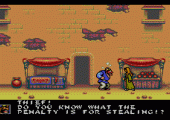
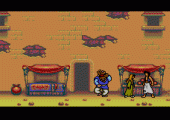
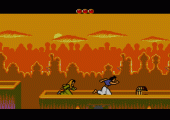
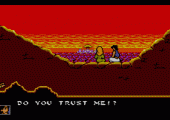
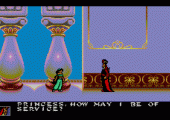
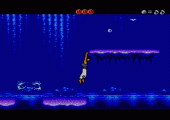
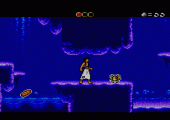
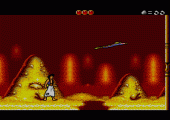

Recent Comments